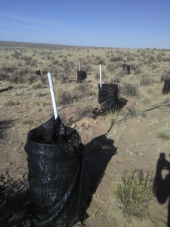posted 12 years ago
After watching a video with David Holmgrem, what I was looking at all really sunk in. Land in Ohio is often taken over by a rose bush, hedge apple, crab apple, mulberry, black berry, black raspberry, honey suckle bush and vine (nitrogen fixers), honey locust and black locust (nitrogren fixers), autumn olive and Russian olive (nitrogen fixers) and persimmon guilds! Where I live right now, there is tall fescue, broom sedge, quack grass and Johnson grass growing in between the shrubby patches and beyond them in the hollers is oak nut guild forests. On the ridge tops I herd dairy cattle, goats and donkeys together in a large electric netting pen that I move once if not twice a day. I am able to allot a larger an area for the goats and the cows than would be allotted for them individually. This makes for happier more contented animals as it means they are able to eat more of their favorite foods. The subsequent increase in animal performance is apparent. There are less goat breakouts. The cows and donkeys eat much lower than goats do, eating what the goats would otherwise waste. By allowing these pastures at least 90 days to recover, the guilds are sustained and gradually improved, the animal performance and sustainability and volume of production per acre are all much greater than can be duplicated by industrial agriculture. By using these hedge guilds that are sustainably harvested by the livestock, we can mulch and protect (with thorns) seedling trees such as apples, pears, chestnuts, walnuts, peaches, willows, poplars etc.
Animals like being together. The electric netting protects all of them, young and small. They make friends with each other. Goats and donkeys get plenty of cow licks. I have seen 3 piglets nestled snuggling all in a row like 4 sausages with a 1 month jersey calf. Cows and donkeys protect goats and sheep if they are penned close together. Sometimes I open the fence up and expand it so that the animals can eat down yesterdays feed. This allows the animals extra space to frolic.
My one regret of this method is that it takes a great herd to be given the space for each animal to get full exercise as the enclosure that provides a day or half days ration is not as large as one might expect. To compensate I like to herd my animals out of the pen when I can and they get a chance to run a round and frolic and get their yah yahs out.
I have no idea what exactly is going to happen but I am pretty sure that if my practices were implemented worldwide that we would not have a global crisis.
It's really weird weather we are getting here in Appalachia. My neighbors roses are blooming. It's bloody December. The grass has been growing literally almost every day this month and last month. I really don't think I am going to have to buy any hay this year. I have a bit over 1000 pounds of hay in case of a freak snow storm, but I bet even if that hits it will quickly melt off.
My animals do not need medications or vaccinations. I can buy a wormy anemic animal at auction and turn him around with my practices (nature) and natural medicine foods like honey and herbs. Though it is often said that organic goats are "nearly impossible" in most of the United States, I feel confident that I could successfully grow them organic and of premium quality in almost any state in the union.
P.S. I am looking for a job.








